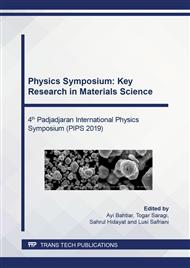p.297
p.303
p.310
p.315
p.320
p.329
p.338
p.345
p.351
The Effect of Fermentation Process on Physical Properties of Organic Material from Domestic Food Waste
Abstract:
Organic material produced from domestic food waste can be functionalized as useful product such as fish feed by fermentation process. The fermentation process changed several properties such as nutrition content and particle size. Here, we reported the effect of fermentation process on physical properties of organic material from domestic food waste. In this study, fermented product will be conducted to become fish feed. The fermentation was performed by using commercial probiotic BIOM-S with various levels of probiotic from 0 to 10% using solid substrate fermentation method. The physical properties including nutritional content, particle size, distance between particles, and functional group of fermented organic material from domestic food waste were investigated. After fermentation, it is found that the best level of probiotic use is 8%, which are crude protein increased from 15.58% to 26.16% and crude fiber content decreased from 4.88% to 3.71%. The average particle sizes and distance between particles of fermented domestic food waste fermented by 8% probiotic were 147.723 µm and 1708.802 µm, respectively, while the functional group did not change after fermentation. The present result indicated that fermentation process effected to improve the quality of organic material from domestic food waste.
Info:
Periodical:
Pages:
345-350
Citation:
Online since:
August 2020
Keywords:
Price:
Сopyright:
© 2020 Trans Tech Publications Ltd. All Rights Reserved
Share:
Citation:


